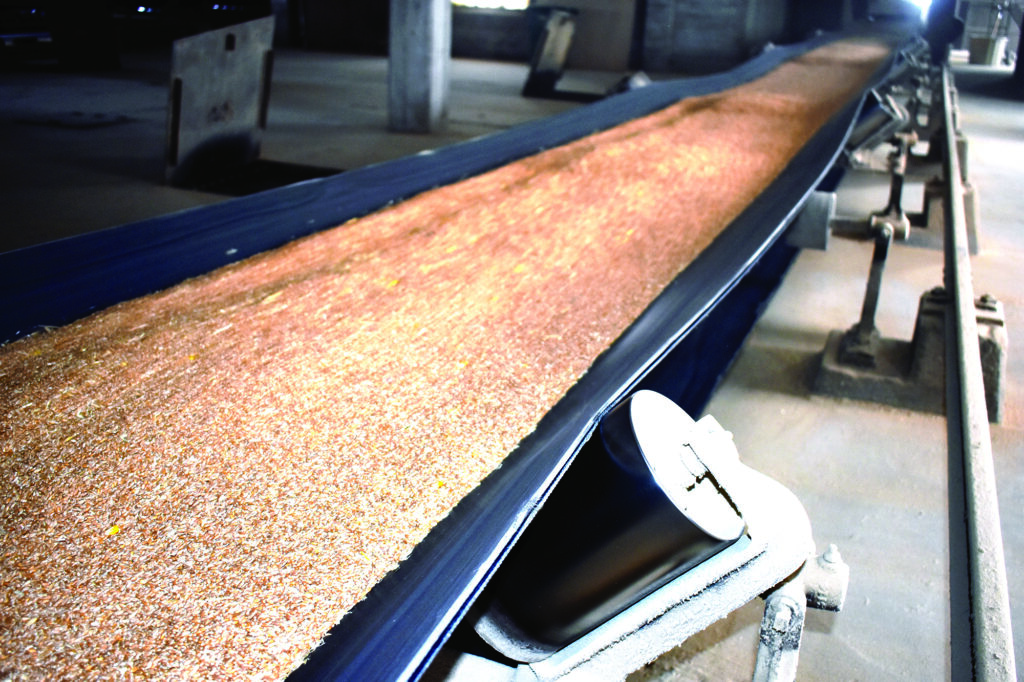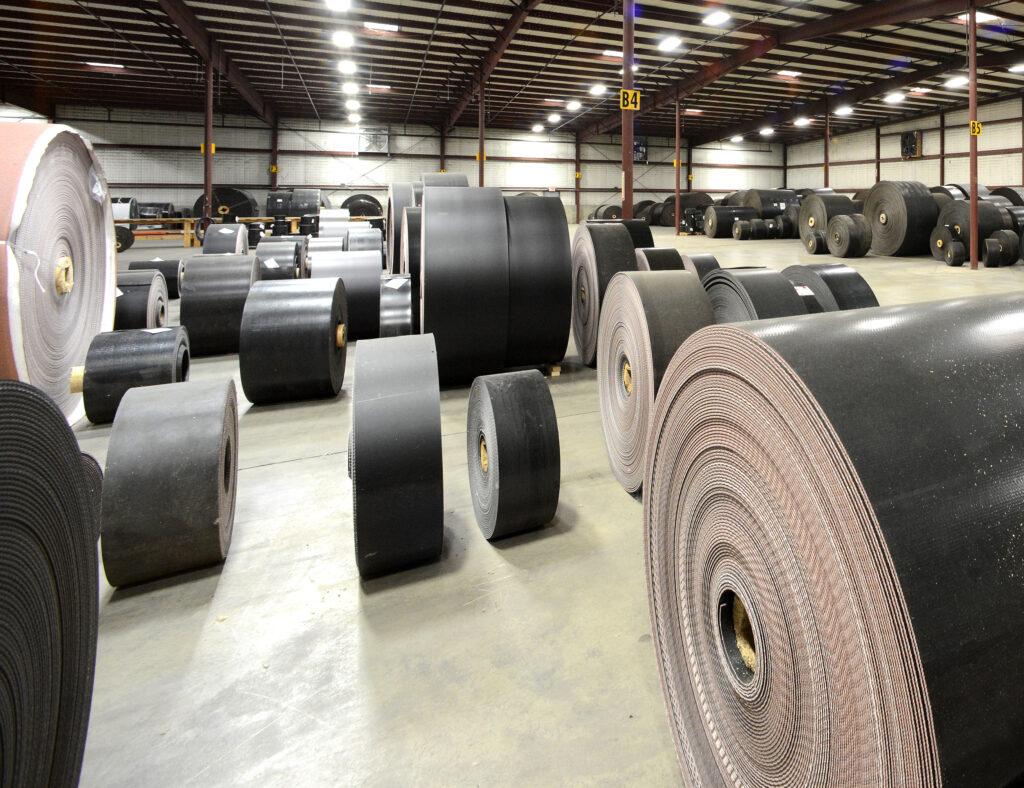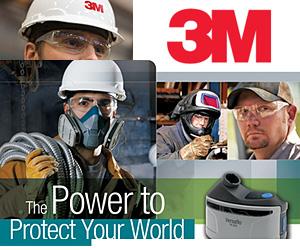When it comes to handling grain and agricultural products, a reliable grain conveyor system is crucial for efficient and safe operations. The conveyor belt plays an important role in this process, as it ensures the smooth and continuous movement of grains from one point to another. Having the right belt in place also ensures specialty grains are handled with care.
However, selecting a grain conveyor belt can be a challenging task. Those in the manufacturing industry know that selecting the right belt for your conveyor system is not a one-size-fits-all approach.
There are various factors that must be taken into consideration when choosing the appropriate conveyor belt for your grain handling needs.
Why Is Selecting the Right Grain Conveyor Belt Important?

Grain is an incredibly fragile product, meaning it must be handled with extreme care during all phases of factory operations. Automated systems, such as grain handling equipment, allow operations to be more effective and efficient, but this is only true if production is successful.
For that reason, it’s important to choose the right grain conveyor belt to avoid damaging the grain product, ensure safe operations for factory workers, and avoid product contamination. Additionally, having the appropriate grain conveyor belt for your operation can:
- Enhance Efficiency: A well-chosen conveyor belt ensures the smooth and uninterrupted flow of grains, minimizing downtime and maximizing productivity. Also, the right belt width and speed help optimize throughput and handling capacity.
- Prevent Damage to Grain: Using the right conveyor belt minimizes any risk of damage to the grain product during transportation. Belt material, strength, and load capacity all play a crucial role in preventing spillage, breakage, or crushing of the grains. With the right belt, manufacturers can ensure quality and maintain market value.
- Maintain Safety of Operations: A suitable conveyor belt enhances safety in grain handling facilities. By selecting a belt that complies with safety standards and incorporates necessary safety features, such as emergency stop buttons and guarding, the risk of accidents and injuries to operators can be significantly reduced.
- Ensure Longevity and Durability: Manufacturers can ensure long-term durability and reduce maintenance costs after investing in the right conveyor belt. You’ll need to choose a belt that is designed to withstand the specific environmental conditions and load conditions of grain handling, thereby minimizing the need for frequent replacements and repairs.
- Protect Against Contamination: Grain handling involves the risk of contamination from moisture, dust, and other contaminants. Selecting a conveyor belt that is resistant to moisture and easy to clean up helps prevent spoilage and maintains the integrity of the grains throughout the handling process.
- Comply with Regulations: Depending on the region and industry, there may be specific regulations and standards in place for grain handling facilities. Selecting the right conveyor belt that meets or exceeds these regulations ensures compliance and prevents potential legal issues or fines.
- Optimize Cost: Making an informed choice when selecting a conveyor belt allows you to strike a balance between cost and performance. By understanding your specific grain handling needs and choosing a belt that meets those requirements, you can avoid overpaying for unnecessary features or risking inadequate performance due to cost-cutting measures.
7 Factors to Consider When Choosing a Grain Conveyor Belt


When choosing the right conveyor belt for your grain handling equipment, you’ll want to fully understand not only belt types and specifications but also the product being transferred. If the product itself is not considered during the selection process in addition to the belt, you may lose time and money related to product loss or contamination.
To avoid losing profit and ensure a safe grain product for the consumer, consider the following factors when choosing a belt conveyor for grain.
1. Conveyor Belt Material
The choice of conveyor belt material depends on several factors, including the type of grains being transported, the environmental conditions, and the required durability.
Common options include rubber, PVC, nylon, and polyester. Rubber belts are known for their flexibility and excellent resistance to abrasion, while PVC belts are lightweight and suitable for indoor applications. Nylon and polyester belts offer high tensile strength and are suitable for heavy-duty operations.
2. Belt Width and Speed
The width of the conveyor belt should be determined based on the volume of grains to be transported. A wider belt allows for increased capacity and reduces the risk of spillage.
Additionally, consider the required speed of the conveyor system. Higher speeds can increase throughput, but it’s essential to ensure that the belt can handle the load without compromising safety or damaging the grains.
3. Belt Strength and Load Capacity
The strength and load capacity of the conveyor belt are crucial considerations to prevent breakdowns and optimize efficiency, as overloading the belt can result in premature wear and tear. Instead, determine the maximum load the belt will need to carry and select a belt with an appropriate load capacity and durability.
4. Resistance to Moisture and Contamination
Grain handling environments often involve moisture, dust, and other contaminants. It’s crucial to choose a conveyor belt that can withstand these conditions without deteriorating.
Look for belts with moisture-resistant coatings or materials that prevent the absorption of moisture. The belt’s surface should also be easy to clean to avoid grain spoilage or contamination.
5. Belt Tracking and Spillage Prevention
Proper belt tracking ensures that the conveyor belt remains centered and aligned, minimizing the risk of conveyor belt problems like severe damage and spillage. It’s best to consider conveyor belts with tracking systems that will automatically maintain alignment and adjust when needed.
Additionally, you’ll want to look for features such as side skirts and containment systems, as these can help prevent grain spillage and minimize product waste.
6. Maintenance and Longevity
Select a conveyor belt that is easy to maintain and offers long-term durability. Opt for belts that require minimal lubrication and have a long lifespan. Regular inspections and maintenance should be part of your grain handling routine to identify any signs of wear or damage and take necessary preventive measures.
7. Safety Considerations
Best practices for safety must be a priority when selecting a grain conveyor belt. For this reason, the belt you choose must comply with all safety regulations and standards, such as fire resistance and anti-static properties.
Other safety features are also important for fostering a hazard-free work environment and protecting operators from harmful accidents. These features may include emergency stop buttons, guarding, and interlocking systems.
Choosing the right grain conveyor belt requires careful consideration of various factors. By understanding your specific grain handling needs and evaluating these factors, you can select a conveyor belt that ensures efficient, reliable, and safe operations for your agricultural facility.
Consult with our industry experts at IBT for guidance in finding the perfect grain conveyor belt by contacting us today, or shop conveyor belting options on shopIBT.com.





